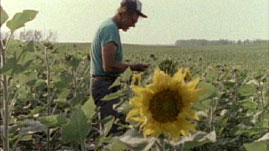Teachers' Domain - Digital Media for the Classroom and Professional Development
User: Preview

Source: Interactive NOVA: "Earth"
Fueled by economic pressure to maximize crop yields and government incentives to produce only one type of crop, contemporary American farmers have been facing a crisis reminiscent of one that hit the Great Plains in the 1930s. In this video segment adapted from Interactive NOVA, learn why more and more farmers are opting for sustainable, organic farming practices to help preserve the valuable topsoil that they rely on for their livelihoods and society relies on for a continuing supply of grains and produce.
Organic Farming: Conserving Topsoil (Spanish audio) (Video)
Soil is a complex mixture of water, minerals, gases, and plant and animal remains. It develops from the chemical and mechanical weathering of solid rock and the mixing of the resulting rock particles with decaying organic matter. Soil has three primary layers. Topsoil, the layer nearest the surface, is the "living" part of the soil, inhabited by bacteria, fungi, and earthworms. It is darker in color than the other layers due to the presence of more humus, or decayed organic matter. Below the topsoil is mineral-rich subsoil, and below this is partially weathered bedrock, which will eventually develop into subsoil.
Erosion of soil by wind, water, and gravity occurs naturally, the rate at which it occurs being dependent on factors such as slope, wind, and the presence or absence of tree cover. Generally, new topsoil forms about as fast as existing topsoil erodes. However, certain human activities, such as grazing livestock and clearing of land for development, can upset this natural balance and accelerate erosion.
When land is cultivated for commercial agriculture, vegetation is typically removed, leaving topsoil exposed and more susceptible to erosion. More than three billion tons of topsoil erodes off from United States farms each year -- seven times more topsoil than is developed naturally. Faced with serious threats to their livelihoods, many farmers have adopted agricultural practices intended to preserve topsoil. Aiming to conserve and enhance soil structure, reduce the use of synthetic energy inputs, and replace human-made additives such as pesticides and fertilizers, these practices combine aspects of organic farming and sustainable agriculture. They rely on traditional techniques or natural amenities rather than chemical applications and ill-suited machinery characteristic of "agribusiness" practices.
The technique of planting non-cash crops such as clover and rye between crop rows preserves topsoil in two ways. First, covering the ground helps restrict weed growth, retain moisture, and reduce runoff. Second, once the plants are plowed into the ground and decompose, nitrogen essential for prolonged soil health returns to the ground. Plowing in circular bands along the contours of the land slows the flow of water and any topsoil it might carry down a slope. A third technique, constructing step-like ridges called terraces by leveling sections of a hillside, reduces runoff by creating flatter terrain and shorter sections of slope.
 Loading Standards
Loading Standards Teachers' Domain is proud to be a Pathways portal to the National Science Digital Library.
Teachers' Domain is proud to be a Pathways portal to the National Science Digital Library.
